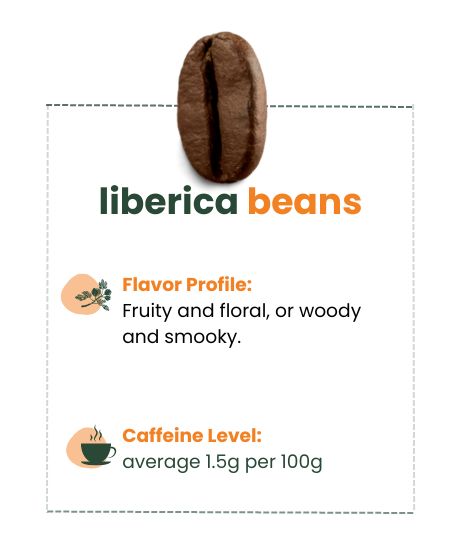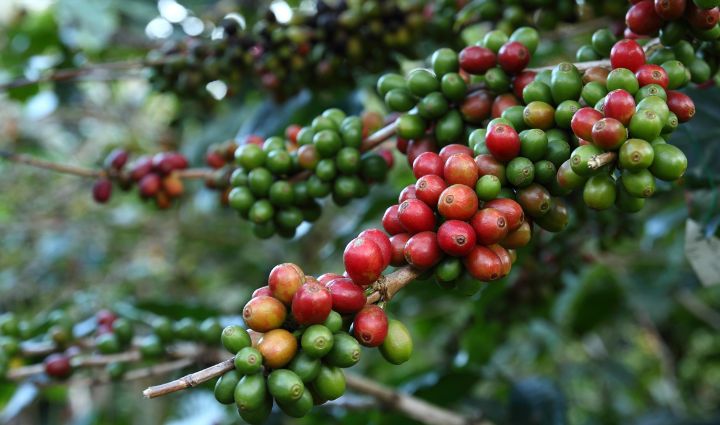Overview
Liberica coffee, originating from western and central Africa, is a coffee species that remains relatively less recognized.

Origin and Cultivation
Liberica coffee is believed to have originated in the forests of Liberia, hence its name. It was first discovered and described by botanists in the mid-19th century. The exact wild ancestor of Liberica is still uncertain, but it is thought to be a native species of the region.
Today, Liberica coffee is grown in several countries, with the Philippines being the most prominent producer. It is also cultivated to a lesser extent in countries like Malaysia, Liberia, and parts of Indonesia.
Cultivating Liberica coffee presents some unique challenges and distinctions compared to other coffee species:

Other related article: Types of Coffee Beans
Tree size
Liberica coffee trees are known for their large size, with some reaching up to 20 meters (65 feet) in height. The size of the trees makes it more challenging for farmers to manage and harvest the cherries compared to smaller coffee species.
Bean size and shape
Liberica coffee beans are significantly larger than both Arabica and Robusta beans. They also have an asymmetrical shape, commonly referred to as “elephant ear” or “banana-shaped” beans.
While Liberica coffee represents a small portion of the global coffee market, it holds a special place in the coffee world due to its unique flavor profile and cultural significance in certain regions. Exploring the origin and cultivation of Liberica coffee offers a fascinating glimpse into the diversity and richness of coffee species worldwide.
Flavor Profile
Liberica coffee has a distinct flavor profile that sets it apart from other varieties. It is often described as having a bold, full-bodied taste with unique aromatic characteristics, including floral and fruity notes. Liberica coffee is known for its low acidity and intense, smoky flavors.
Caffeine Content
Liberica coffee is generally has a caffeine content similar to Robusta coffee and higher than Arabica coffee. The caffeine content of Liberica beans can range from approximately 1.5% to 2.7% by weight, depending on factors such as growing conditions, processing methods, and specific varieties within the Liberica species.
The higher caffeine content in Liberica is a characteristic it shares with Robusta coffee (Coffea canephora), which is known for its higher caffeine levels compared to Arabica coffee (Coffea arabica). However, it’s important to note that variations in caffeine content can occur within coffee species, and the specific caffeine content of Liberica can vary between different sources and growing regions.
The caffeine in Liberica coffee contributes to its stimulating effects and can provide a robust and energetic cup of coffee. However, individual sensitivities to caffeine can vary, and some individuals may find the higher caffeine content of Liberica coffee to be too strong for their preferences.
It’s worth mentioning that while caffeine content is an important aspect, the overall flavor profile and taste characteristics of Liberica coffee are distinct and may be of interest to coffee enthusiasts looking for unique and different coffee experiences.
Varieties of Liberica
Liberica coffee is a coffee species that has several known varieties within its genetic makeup. However, it’s important to note that Liberica coffee is less cultivated and commercially available compared to Arabica and Robusta. As a result, the number of distinct Liberica varieties is relatively limited. Here are a few recognized varieties of Liberica coffee:
Liberica Baraco
This is one of the most well-known and widely cultivated varieties of Liberica coffee. It is primarily grown in the Philippines, particularly in the Batangas and Cavite regions. Liberica Baraco beans are large and have a distinctive, elongated shape.
Liberica Excelsa
Liberica Excelsa is a less common variety that is grown in regions like Malaysia and the Philippines. It is known for its unique flavor profile, which can include fruity and floral notes.
Liberica Dewevrei
This variety is named after the Belgian botanist Émile Auguste Joseph De Wildeman. Liberica Dewevrei is native to the Democratic Republic of Congo (formerly known as Zaire) and has been primarily cultivated in Africa.
It’s worth noting that Liberica coffee has lower genetic diversity compared to other coffee species like Arabica and Robusta. This limited genetic diversity can result in less variation in flavor profiles and cup characteristics among different Liberica varieties.
Additionally, the cultivation and availability of Liberica coffee are more region-specific, with the Philippines being the primary producer and exporter of Liberica beans. Other regions, such as Malaysia and parts of Africa, also have some cultivation of Liberica coffee but on a smaller scale.
Due to the unique flavor profile and rarity of Liberica coffee, it is often sought after by coffee enthusiasts and those looking to explore different coffee experiences.
Growing Condition
Liberica coffee has specific growing conditions that are essential for its successful cultivation. Here are the key factors involved in growing Liberica coffee:
Climate
Liberica coffee is primarily grown in regions with a tropical climate. It thrives in areas with temperatures ranging from 24 to 30 degrees Celsius (75 to 86 degrees Fahrenheit). Liberica prefers a relatively stable and warm climate without extreme temperature fluctuations.
Altitude
Altitude: Liberica coffee is typically cultivated at lower altitudes compared to Arabica coffee. It can be grown from sea level up to around 600 meters (1,970 feet). This lower altitude requirement makes it suitable for regions with flat or gently sloping terrains.
Rainfall and Water
Rainfall and Water: Liberica coffee prefers regions with a well-distributed rainfall pattern, averaging around 1,500 to 2,500 millimeters per year. It requires a significant amount of water but also needs good drainage to prevent waterlogging. Adequate irrigation systems may be necessary in areas with irregular or insufficient rainfall.
Soil
Liberica coffee prefers deep, well-drained soils with good fertility. It can adapt to a variety of soil types, including sandy loam, clay loam, and volcanic soils. The soil should have good water-holding capacity while allowing excess water to drain effectively. Maintaining soil fertility through organic matter and appropriate fertilization is crucial for healthy plant growth.
Shade
Liberica coffee benefits from partial shade during its early growth stages. Providing shade helps protect the young plants from excessive sunlight and heat stress. However, once established, Liberica can tolerate higher levels of sunlight exposure compared to shade-dependent coffee species like Arabica.
Pest and Disease
Liberica coffee can be susceptible to various pests and diseases common to coffee plants, such as coffee berry borers, leaf rust, and nematodes. Implementing integrated pest management strategies, regular monitoring, and appropriate cultural practices are essential for minimizing the impact of pests and diseases.
It’s important to note that specific growing conditions may vary depending on the region, local climate, and specific variety of Liberica being cultivated. Farmers often adapt their cultivation practices to the unique characteristics of their location. Additionally, factors such as pruning, fertilization, and weed control play significant roles in maximizing Liberica coffee plant growth and yield.
Cultivation Challenges
Cultivating Liberica coffee presents several challenges for farmers. Here are some of the common challenges associated with Liberica coffee cultivation:
Limited Cultivation
Liberica coffee is less commercially cultivated compared to Arabica and Robusta, which makes it challenging for farmers to access quality planting materials and established farming practices. The limited availability of Liberica plants and seeds can hinder widespread cultivation and the exchange of knowledge among farmers.
Market Demand and Price
The demand for Liberica coffee is relatively niche compared to other coffee species. It is often considered a specialty or unique coffee, appealing to a specific segment of coffee enthusiasts. The limited market demand and niche status can result in lower market prices and a more restricted consumer base, making it challenging for farmers to achieve profitability.
Genetic Variability
Liberica coffee has lower genetic diversity compared to other coffee species. This limited genetic variability can result in less resistance to pests, diseases, and environmental stresses. It can also lead to a narrower range of flavors and cup profiles, limiting the potential for differentiation and quality improvement.
Larger Tree Size
Liberica coffee trees are known for their large size, which presents challenges in terms of managing and harvesting the crop. The tall and broad trees require specialized techniques, tools, and infrastructure to effectively care for and harvest the cherries. This can add complexity and costs to the cultivation process.
Pest and Disease Management
Like other coffee species, Liberica coffee is susceptible to pests and diseases that can negatively impact yield and quality. Common pests include coffee berry borers, coffee leaf miners, and nematodes. Diseases such as coffee leaf rust and root diseases can also pose significant challenges. Implementing effective pest management strategies and disease prevention measures is crucial to mitigate these challenges.
Climate Change
Climate change can have adverse effects on coffee cultivation, including Liberica. Rising temperatures, unpredictable weather patterns, and increased incidences of pests and diseases can all impact the viability and productivity of coffee farms. Adapting to these changing conditions and implementing climate-smart agricultural practices becomes crucial for the long-term sustainability of Liberica coffee cultivation.
Despite these challenges, Liberica coffee offers a unique flavor profile and characteristics that can be appreciated by coffee connoisseurs. With appropriate agronomic practices, market development efforts, and research focused on addressing the specific challenges, Liberica coffee cultivation has the potential to thrive and contribute to the diversity of the coffee industry.
Pingback: Types of Coffee Beans - Me and My Beans Talk
Comments are closed.